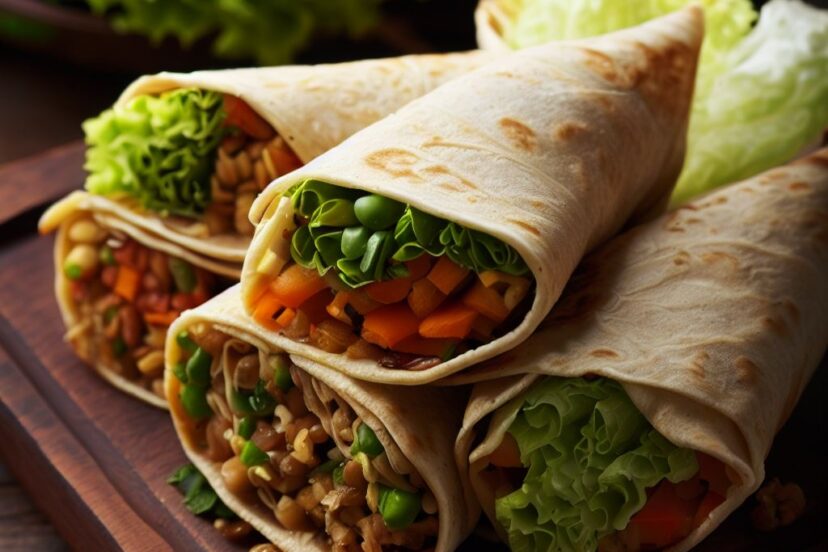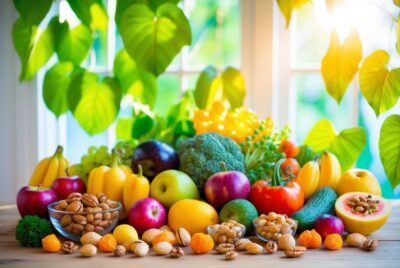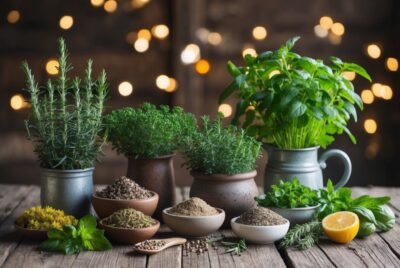Vegetarian Wraps: The Vegetarian Wrap Revolution
*We may earn a commission for purchases made using our links. Please see our disclosure to learn more.
Vegetarian Wraps: 10 Flavor-Packed Recipes for Healthy Eating
Vegetarian wraps have become a staple in healthy eating, offering a versatile and nutritious option for meals, especially lunch. I appreciate their ease of preparation and the ability to pack a wholesome, balanced mix of proteins, vegetables, and flavor into a convenient handheld package. Whether it’s a tortilla, lettuce leaf, or pita pocket, the base of a vegetarian wrap is just the beginning of its potential.

I’ve found that the key to a satisfying vegetarian wrap lies in its ingredients. A rich slather of hummus or a homemade vegan mayo can act as both a glue and a flavor booster. Fresh vegetables like lettuce, spinach, tomatoes, onions, avocados, cucumbers, and carrots add not only crunch and color but also essential vitamins and fibers to the meal. A thoughtful addition of proteins such as tofu or beans can make a wrap a filling and energizing option for any time of the day.
Incorporating a variety of cuisines and flavors into vegetarian wraps keeps lunchtime interesting. For instance, taking inspiration from Mediterranean or Asian dishes can transform the wrap into a culinary adventure. Adding spices, vinegar, or other dressings elevates the taste and can cater to individual preferences. In my experience, these wraps are an excellent way for anyone to include more vegetables in their diet without compromising on taste or satisfaction.
Selecting Quality Ingredients for Vegetarian Wraps

In crafting the perfect vegetarian wrap, my emphasis always lies on incorporating vibrant, fresh vegetables, hearty protein sources, and the ideal wraps to hold everything together.
Choosing Fresh Vegetables for Vegetarian Wraps
Freshness is key when picking vegetables for my wraps. I ensure that the lettuce and spinach are crisp, the carrots and bell peppers have a firm texture, and the onion retains its sharp, pungent aroma. Tomatoes must be ripe but not overly soft, and cucumbers should have a bright, even color without any spots or blemishes.
Ideal Fresh Veggies:
- Lettuce leaves: Crisp, green, no wilting
- Spinach: Dark leaves, no yellowing
- Carrots: Firm, bright orange, no soft spots
- Bell Peppers: Glossy, firm, no wrinkles
- Cucumber: Firm, deep green color
- Tomato: Firm, bright red, aromatic
- Onion: Papery skin, no sprouting
- Mushrooms: Dry, firm, no dark spots
- Avocado: Slight give under pressure, not mushy
Protein Sources for Vegetarians
Protein is crucial in my vegetarian diet. I often include options like tofu, tempeh, and a variety of beans. For vegan wraps, I steer clear of dairy and opt for plant-based cheeses or hummus for that protein punch. Nuts and seeds can also be a flavorful addition for both texture and protein.
Protein Choices:
- Beans: Black, pinto, chickpeas
- Non-dairy cheese: Frequently soy or nut-based
- Tofu/Tempeh: Firm, well-pressed
- Nuts/Seeds: Almonds, pumpkin seeds, sunflower seeds
Finding the Right Wraps and Breads
The foundation of a great vegetarian wrap lies in the choice of wrap or bread. I aim for whole-grain tortillas or gluten-free options when needed. When feeling adventurous, I substitute tortillas with collard greens for a low-carb version. Freshness and flexibility of the wraps are important to ensure they don’t tear when rolling.
Wrap Options:
- Whole-grain tortillas: Soft, pliable
- Collard greens: Large, sturdy leaves
- Gluten-free options: Well-sealed packaging to ensure freshness
By prioritizing fresh produce, substantial protein, and suitable wraps, I compose vegetarian wraps that delight with every bite.
Crafting the Perfect Vegetarian Wraps

Creating a vegetarian wrap that’s both flavorful and satisfying involves careful layering and specific assembly techniques. I’ll guide you through making a wrap that’s packed with taste, using a variety of spreads and fresh ingredients.
Layering for Maximum Flavor
The secret to a richly flavored wrap lies in its layers. Start with a flavorful base such as hummus or pesto, spreading it evenly on a tortilla wrap leaving a small border around the edge. Next, add grated ginger for a zesty kick or roasted sweet potato for warmth and sweetness. Include a variety of vegetables like bell peppers, cucumbers, and red onions to achieve a balance between crunch and flavor. For those looking for creamier vegan options, consider vegan cheese substitutes or a tahini-based dressing.
- Essential Layering Ingredients:
- Base: Hummus, vegan pesto, tahini
- Flavor Enhancers: Grated ginger, roasted sweet potato
- Vegetables: Spinach, red bell peppers, cucumbers, purple cabbage
- Protein: Vegan cheese, halloumi (for vegetarians)
- Final Touch: Kalamata olives, fresh herbs
Layering Tip: Balance flavors by combining fresh, pickled, and roasted vegetables with herbs and spices.
Wrap Assembly Techniques
The assembly of a wrap is crucial for both taste and structure. I usually spread my chosen base on a tortilla or a lettuce leaf, depending on my preference for a tortilla wrap or a lighter vegan lettuce wrap. After spreading, I arrange the fillings in a row down the center, being careful not to overfill.
Assembly Steps:
- Spread: Apply base spread within 1cm of the tortilla edge.
- Arrange: Place the vegetables and protein in wide rows.
- Wrap: Fold the sides to cover the edges of the filling, then roll from bottom up, making sure the sides stay tucked in.
To make Mediterranean wraps, add ingredients like cucumbers, tomatoes, red onions, and a drizzle of olive oil-lemon dressing. For halloumi wraps, include slices of grilled halloumi cheese for a salty, chewy texture that pairs well with crisp vegetables.
By focusing on the right combination of ingredients and mastering the wrap technique, you can create vegetarian wraps that are both flavorful and enjoyable to eat.
Innovative Recipes and Combinations

In my experience, vegetarian wraps offer a canvas of endless possibilities, combining a variety of flavors, textures, and ingredients from around the world. From hearty chickpea wraps to spinach wraps filled with exotic spices, each recipe is a testament to culinary creativity and can cater to vegan diets with simple substitutions.
Global Inspirations for Vegetarian Wraps
I am always excited to explore global cuisines through the lens of vegetarian wrap recipes. One standout is the Thai Peanut Wrap, a perfect blend of sweet and tangy flavors with a punch of garlic and a hint of spice. Here’s a simple yet robust combination you might try:
- Sauce: Homemade peanut sauce using peanut butter, soy sauce, and a hint of sugar.
- Veggies: Crunchy carrots, bell peppers, and purple cabbage for a colorful mix.
- Proteins: Tofu can be marinated and then baked or stir-fried for a satisfying chew.
For a Mediterranean twist, falafel wraps are another special creation. Combine falafel balls with a drizzle of tahini sauce, add greens like spinach, and top it off with diced tomatoes and a spoonful of homemade tzatziki sauce made from dairy or vegan yogurt.
Seasonal Specialties
I believe in harnessing the freshness of the seasons, which is why my take on Seasonal Specialties often includes a creative use of seasonal produce and unique sauces. Let’s consider a spring-inspired wrap:
- Greens: Fresh spinach or lettuce as the base.
- Veggies: Lightly sautéed asparagus and green peas, indicative of spring.
- Cheese: Slices of grilled halloumi or a spread of cream cheese for added texture.
In autumn, a harvest wrap could feature roasted butternut squash with smashed chickpeas, accented by a bold vegan ranch or classic pesto, easily converted to a vegan version with nutritional yeast and cashews.
By making use of meal prep strategies, these veggie wraps can also become practical weekly staples. I like to prepare a batch of sauces like hummus or vegan tzatziki in advance and keep a variety of chopped vegetables ready for quick assembly. Whether it’s a rice wrap filled with vibrant veggies or a spinach wrap bursting with flavor, the objective is to create a special, wholesome meal that is as satisfying as it is nutritious.
Health Benefits and Nutritional Information

When I prepare vegetarian wraps, I focus on their nutritional value and the health benefits they offer. I make sure they’re not only flavorful but also packed with essential nutrients.
Understanding Macronutrients
Carbohydrates: Vegetarian wraps often use whole grains like quinoa or gluten-free alternatives such as lettuce leaves. A lettuce leaf wrap provides a low carb option, whereas a quinoa wrap is rich in complex carbohydrates and protein.
- Quinoa Wrap: High in fiber and complete protein.
- Lettuce Leaf Wrap: A low-calorie, low carb vehicle for filling.
Proteins: For a protein boost, I incorporate ingredients like beans or tofu. These plant-based proteins are vital for muscle repair and overall body function.
- Beans: A great source of protein and fiber that complement any wrap.
- Tofu: A versatile vegan protein that absorbs flavors well.
Fats: I use healthy fats like avocado slices or a spread of hummus to add creaminess and satiety to the wraps.
- Avocado: Offers monounsaturated fats, which are heart-healthy.
- Hummus: Provides a mix of protein, healthy fats, and fiber.
The Role of Vitamins and Minerals
Vitamin C: It’s essential for immune function and skin health. I often include bell peppers or sweet potatoes in my wraps to up the vitamin C content.
- Bell Peppers: Crisp, colorful, and full of vitamin C.
- Sweet Potato: Adds a sweet note and is also a great source of this vitamin.
Other Vitamins and Minerals: A variety of vegetables like spinach, carrots, or cucumbers, contribute additional vitamins such as vitamin K, A, and minerals like iron and potassium.
- Spinach: An excellent source of iron, vitamin K, vitamin A, and calcium.
- Carrots: High in beta-carotene, which the body turns into vitamin A.
Nutritional Balance: By choosing the right combination of ingredients, vegetarian wraps become a powerhouse of nutrition. They can be tailored to accommodate dietary preferences, such as vegan or gluten-free, ensuring a healthy, balanced meal.
Storing and Preparing Vegetarian Wraps Ahead of Time

In my experience, the success of a vegetarian wrap hinges on how well it’s prepared and stored. Proper technique ensures that every meal is as fresh and flavorful as if it were made moments ago.
Meal Prep Strategies
When I meal prep wraps, I prefer to start with the fillings. For a veggie wrap, chopping bell peppers, dicing green onions, or roasting sweet potatoes in advance can save time. It’s essential to keep ingredients dry, especially when dealing with lettuce leaves or cabbage, to prevent a soggy wrap. I often keep my dressings like hummus, avocado, or sriracha separate until right before serving to maintain freshness.
- Bread-based Wraps: If I use tortillas or pita, heating them slightly before assembling helps them become more pliable.
- Leafy Greens: For a lettuce wrap, blanching leaves like romaine lettuce briefly makes them more flexible without wilting.
I like to layer my wraps with something creamy on the bottom, such as hummus or avocado, which creates a barrier and helps to keep the wrap from becoming too moist. Adding in proteins like black beans or carbs like sweet potatoes add sustenance, while a sprinkle of lime juice and basil just before wrapping brings freshness.
Optimal Storage Solutions
For storing my wraps, I focus on both the short-term and long-term solutions.
Short-Term Storage:
- Wraps intended for consumption within 24 hours can be tightly wrapped in parchment paper and stored in a cool and dry place.
- Freshness for bread-based wraps is best maintained in airtight containers lined with paper towels to absorb excess moisture.
Long-Term Storage:
- For freezing, I individually wrap each tortilla wrap or lettuce wrap in foil and place them in freezer bags. This approach works best with fillings that freeze well, such as cooked black beans and roasted sweet potatoes.
When it’s time to eat, I gently thaw wraps in the refrigerator if they’re frozen and reheat bread-based wraps in an oven or toaster to bring back some of the crispiness if desired. By keeping ingredients separate and using the right storage techniques, leftovers become less of a last resort and more of a planned delight.
Frequently Asked Questions
In this section, I’ll address some common inquiries about vegetarian wraps, providing practical answers that focus on ingredients, recipes, and health benefits.
1. What are some easy vegetarian wrap recipes for a quick meal?
For a quick meal, tofu lettuce wraps mimic the flavors of PF Chang’s with a savory mix of tofu, mushrooms, water chestnuts, and a zesty sauce. Another speedy option involves roasted vegetables, such as bell peppers and sweet potatoes, complemented by hummus or tahini in a wrap.
2. Which ingredients are commonly used in a grilled veggie wrap?
A grilled veggie wrap typically includes bell peppers, zucchini, and carrots. Brushing these vegetables with olive oil and seasoning before grilling enhances their flavor. The veggies can then be wrapped in a tortilla with a spread like hummus or avocado.
3. How can you increase the protein content in vegetarian wraps?
To boost protein, integrate ingredients such as chickpeas, mashed and seasoned, or use a bean spread. Cottage cheese and tofu are also protein-rich additions that can be included in the filling.
4. What are the best fillings to include in a vegetarian wrap for lunch?
The best fillings for a lunch wrap might feature fresh and flavorful components like homemade hummus, crisp cucumbers, artichokes, and feta cheese. These fillings, quick to assemble, provide a satisfying and nutritious midday meal.
5. Are vegetarian wraps considered a healthy option for weight loss?
Vegetarian wraps can be a healthy choice for weight loss if filled with low-calorie, nutrient-dense ingredients like fresh vegetables and lean protein sources. Keeping the wrap balanced and not overloaded with high-calorie dressings contributes to a healthier meal option.




